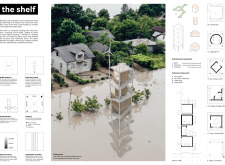5 key facts about this project
Elevated Structure and Modular Design
At the core of "The Shelf" is its elevated modular structure, which allows for a compact living footprint while providing necessary elevation above potential flood levels. The design incorporates vertical pillars that support the living units, ensuring structural integrity and resilience. Each unit is constructed using prefabricated wooden modules that allow for rapid assembly, making the housing adaptable to various site conditions.
This modular approach enables flexibility in design, allowing for customization based on individual or community needs. The project emphasizes vertical privacy through stacked units, which optimizes space and encourages communal interaction at different levels of the structure. The inclusion of transparent panels in the design enhances natural light penetration while promoting a connection to the surrounding environment.
Sustainability and Resource Efficiency
The design of "The Shelf" integrates sustainable practices through the incorporation of essential systems that foster self-sufficiency. A wind turbine provides renewable energy for the units, minimizing reliance on traditional energy sources. Furthermore, a water collection system is integrated to capture rainwater, which can be utilized for domestic purposes, reducing the overall ecological footprint of the project.
Materials selected for "The Shelf" are critical to its functionality. Hot-galvanized steel is used for its structural supports, ensuring longevity and resistance to corrosion, while insulation boards enhance the energy efficiency of the residential modules. This careful selection of materials not only meets durability requirements but also reflects a commitment to sustainable construction.
Adapting to Environmental Contexts
"The Shelf" uniquely addresses the specific environmental contexts in which it can be deployed. Its adaptable architecture allows for variations that suit different geographical settings, from urban landscapes to rural areas. The combination of functionality and aesthetic simplicity ensures that the project can fit into diverse settings without disrupting the natural or built environment.
This project diverges from traditional residential designs by prioritizing resilience and adaptability, providing a model for future housing developments in flood-prone regions. It challenges conventional thinking about architecture by proposing a living solution that not only meets current demands but anticipates future environmental changes.
For a comprehensive understanding of "The Shelf," including architectural plans, sections, and design concepts, readers are encouraged to explore the project presentation. Review the various architectural ideas that drive this innovative housing project to gain deeper insights into its practical applications and contributions to sustainable living in vulnerable regions.























